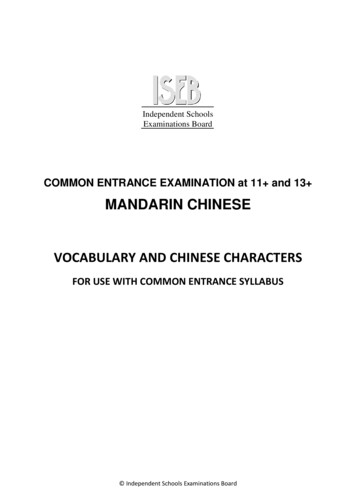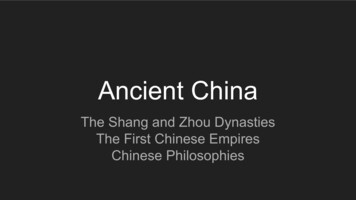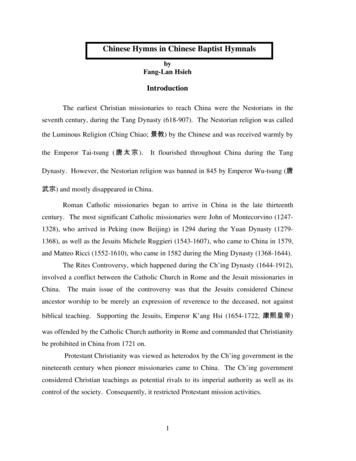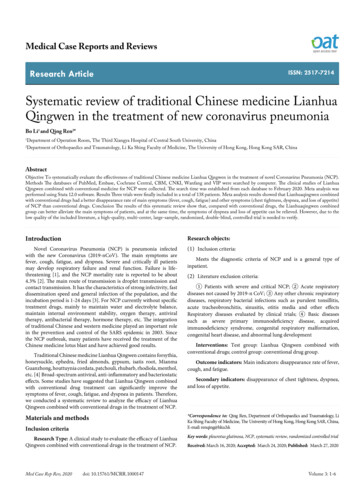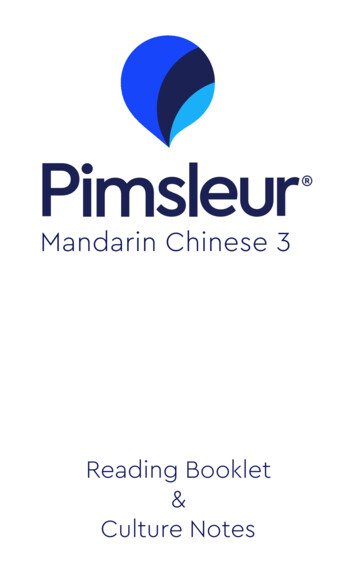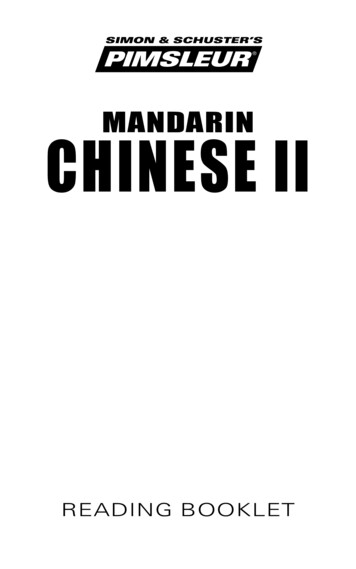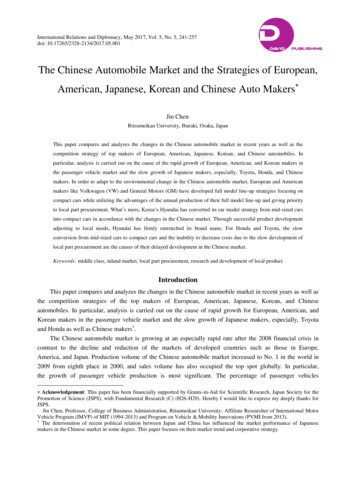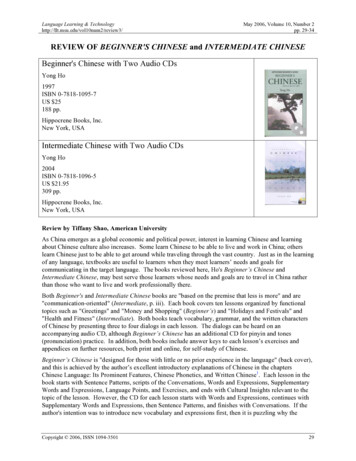
Transcription
Language Learning & Technologyhttp://llt.msu.edu/vol10num2/review3/May 2006, Volume 10, Number 2pp. 29-34REVIEW OF BEGINNER'S CHINESE and INTERMEDIATE CHINESEBeginner's Chinese with Two Audio CDsYong Ho1997ISBN 0-7818-1095-7US 25188 pp.Hippocrene Books, Inc.New York, USAIntermediate Chinese with Two Audio CDsYong Ho2004ISBN 0-7818-1096-5US 21.95309 pp.Hippocrene Books, Inc.New York, USAReview by Tiffany Shao, American UniversityAs China emerges as a global economic and political power, interest in learning Chinese and learningabout Chinese culture also increases. Some learn Chinese to be able to live and work in China; otherslearn Chinese just to be able to get around while traveling through the vast country. Just as in the learningof any language, textbooks are useful to learners when they meet learners’ needs and goals forcommunicating in the target language. The books reviewed here, Ho's Beginner’s Chinese andIntermediate Chinese, may best serve those learners whose needs and goals are to travel in China ratherthan those who want to live and work professionally there.Both Beginner's and Intermediate Chinese books are "based on the premise that less is more" and are"communication-oriented" (Intermediate, p. iii). Each book covers ten lessons organized by functionaltopics such as "Greetings" and "Money and Shopping" (Beginner’s) and "Holidays and Festivals" and"Health and Fitness" (Intermediate). Both books teach vocabulary, grammar, and the written charactersof Chinese by presenting three to four dialogs in each lesson. The dialogs can be heard on anaccompanying audio CD, although Beginner’s Chinese has an additional CD for pinyin and tones(pronunciation) practice. In addition, both books include answer keys to each lesson’s exercises andappendices on further resources, both print and online, for self-study of Chinese.Beginner’s Chinese is "designed for those with little or no prior experience in the language" (back cover),and this is achieved by the author’s excellent introductory explanations of Chinese in the chaptersChinese Language: Its Prominent Features, Chinese Phonetics, and Written Chinese1. Each lesson in thebook starts with Sentence Patterns, scripts of the Conversations, Words and Expressions, SupplementaryWords and Expressions, Language Points, and Exercises, and ends with Cultural Insights relevant to thetopic of the lesson. However, the CD for each lesson starts with Words and Expressions, continues withSupplementary Words and Expressions, then Sentence Patterns, and finishes with Conversations. If theauthor's intention was to introduce new vocabulary and expressions first, then it is puzzling why theCopyright 2006, ISSN 1094-350129
Tiffany ShaoReview of Beginner's Chinese and Intermediate Chineseorganization of the book and the audio CD are not in sync. The amount of vocabulary and number ofexpressions taught in each lesson increases by lesson so that upon finishing the book, "the student willhave learned 90 basic sentence patterns, 300 written characters, and numerous communicative skills"(back cover). The author’s use of "Sentence Patterns" encompasses both grammar structures, such as themodals yao 'to be going to, want', neng 'can, may', and keyi 'can, may' (p. 78-79), and useful terms andchunks, such as yixiar, used with verbs to mean a brief action, and tingshuo, meaning 'I heard' or 'theysay' (p. 81). These 90 basic sentence patterns are recycled throughout the lessons, but since they are allnew to learners, 90 patterns can be quite overwhelming for a beginner.The same can be said for teaching 300 written characters in a beginner’s book, especially since the authoradvises in the introduction on written Chinese that "the emphasis of this or any other beginning course foradult learners is on speaking or communicating, character learning and writing are not given priority" (p.xii). Learners can certainly learn to speak or communicate in Chinese with this book because new wordsand expressions, while presented in Chinese characters, are also romanized in pinyin and translated intoEnglish. In fact, there are textbooks such as Chinese for Dummies (Abraham, 2005) and Chinese in PlainEnglish (De Mente, 1995), which teach Chinese with pinyin alone without Chinese characters at all.Pinyin is used in China to teach pronunciation of Mandarin; however, learning Chinese as a foreignlanguage by pinyin may allow learners to "read" and "speak" Chinese, but not necessary "understand"Chinese. Just as in learning any language, even one whose orthography is similar to English, being ableto speak or pronounce words and phrases does not mean communicative competency. Perhaps the authoracknowledges and compensates for this problem by directing those beginner learners who cannot "resistlearning some characters" to separate software programs, online tutorial sites, and "an exercise book withgrid pages" to practice writing characters (pp. xii – xiii).For learners who just want to be able to speak and understand tourism Chinese, the presentation in eachlesson of paring pinyin with English translations is functional. Together with the audio CD, learners canpick up chunks of useful phrases for greetings, asking for directions, time expressions, and ordering in arestaurant. The recording of the audio is clear, and the rate of speech is slow enough for a beginner tofollow. However, when rate of speech is slowed down, some conversations sound robotic andemotionless. As mentioned before, the Beginner’s book includes a bonus CD on pinyin practice.Although the author does not specifically suggest it, learners may best be served by starting their learningof Chinese by mastering pinyin first. This is especially important since the representation of Chinesesounds using the Roman alphabet can result in odd combinations of consonants and vowels, together withdiacritic marks to indicate the four tones: a learner may very well be wondering "did the CD just saywhat sounded like 'chu' for qu?" The speaker on the pinyin practice CD is exceptionally clear in herarticulation of all possible Chinese sound combinations in four tones; however, she does not leave timeafter each set of combinations for learners to repeat and practice, which would be useful. While the authorprovides a list of these possible sound combinations for the 21 consonants in the appendix to use with theCD, the CD starts off with vowel practice. Unfortunately, there is no itemized visual/textualrepresentation of vowels and vowel combinations, except for a chart in the beginning of the book and inthe introduction on Chinese Phonetics (p. vii). Furthermore, the order of the vowel sounds in the vowelchart and in the introduction does not match the order as recorded on the CD.By learning chunks of key words and phrases, learners who want to be able to speak and understandtourism Chinese can achieve this goal relatively quickly. The author presents these chunks as SentencePatterns which are further explained as grammatical structures and communicative usages in LanguagePoints. This method of teaching grammar structures and language functions works for language learnerswho are used to memorization. However, memorized grammar structures and chunks of words andphrases do not necessarily enable learners to communicate when they are engaged in real-life interactions.By presenting chunks of key words and phrases to learners, the author does not allow learners to discoverfor themselves grammatical structures and the communicative functions in which they are appropriatelyLanguage Learning & Technology30
Tiffany ShaoReview of Beginner's Chinese and Intermediate Chineseused (cf. Biesenbach-Lucas, 2005). In other words, learners do not have to take responsibility for selflearning since the answers and explanations are provided by the textbook/teacher. Once again, the authorseems to compensate for this weakness by stating in the introduction that "Chinese grammar is verysimple," and indirectly quoting the renowned linguist Yuen Ren Chao that "all Chinese grammar issyntax, all Chinese syntax is word order, and therefore all Chinese grammar is word order" (pp. iv and v).In Intermediate Chinese, instead of Sentence Patterns, dialogs and new vocabulary are used to "illustratecommon grammatical patterns" (back cover). Unlike Beginner’s Chinese, this follow-up book focuses onreading and writing of Chinese by presenting a short reading passage, in Chinese characters and pinyin, ineach lesson (the corresponding English translation is provided at the end of each lesson). This suddenfocus on reading and writing of Chinese characters may be a hurdle for learners who learned fromBeginner’s Chinese, which focused more on speaking and communicating. The topics covered inIntermediate Chinese are also less tourism Chinese and more "Chinese for living and working in China."These include Calling and Answering, School and School Life, and Job Hunting and Interviewing. Inother words, this volume is suitable for more academic Chinese taught in classrooms.Presentation and organization of each lesson in Intermediate Chinese are different from Beginner’sChinese. Each lesson starts with Conversations, a short Reading Passage, New Words and Expressions,Supplementary Words and Expressions, Language Points, Exercises, and English translations of thescripts of the conversations and reading passage. The accompanying audio CD follows the order ofpresentation in the textbook, but it does not include Supplementary Words and Expressions. Although,just as in Beginner’s Chinese, Intermediate Chinese is text-heavy, it does include a few simple black-andwhite drawings of people, activities, and objects, such as those that accompany the progressive aspect (pp.43-44), prepositions and directions (pp. 73-76, 86, 88-89), body parts (See Figure 1, p. 125), and Chinesezodiac signs (p. 155).Figure 1. Sample black and white drawing in Intemediate Chinese.Language Learning & Technology31
Tiffany ShaoReview of Beginner's Chinese and Intermediate ChineseIt is possible that a learner is new to Intermediate Chinese who has previous knowledge of MandarinChinese learned from other texts (back cover). If a learner is continuing his or her study from Beginner’sChinese, then the materials presented in Intermediate Chinese should include materials recycled from theprevious volume in addition to new materials. In as early as Lesson 2, the author assumes the learner hasprevious knowledge of "making/talking on the telephone" to be able to complete the exercise on"describing what people are doing in the following pictures" (p. 43), but the term "da dianhua"(making/talking on the telephone) is first introduced in the following lesson (pp. 51 and 54). In general, acursory glance of Intermediate Chinese gives the impression that a learner should have a solidacademically-learned foundation in Chinese, especially in literacy of Chinese characters, to be able tounderstand and learn successfully from this book. While a glossary of vocabulary covered in Beginner’sChinese is included in this follow-up book "to assist learners with making a smooth transition" (p. iv), theamount of Chinese characters might initially be overwhelming.Figure 2. Typical text and layout in both Beginner's and Intermediate ChineseBoth Beginner’s Chinese and Intermediate Chinese are similar in presentation so that a "smoothtransition" is nonetheless possible. In fact, the "look" of the texts is the same: sentences in Chinesecharacters appear first horizontally from left to right, then the same sentences in pinyin using the Romanalphabet is repeated immediately beneath the characters. The Chinese characters are known as "squarecharacters", and "[i]rrespective of the complexity of strokes and structures, each character occupies thesame amount of space as the next one" on the page (p. xiii, Beginner’s). Obviously, using the Latinalphabet to spell out sounds of Chinese characters, however, takes up a variable amount of space toLanguage Learning & Technology32
Tiffany ShaoReview of Beginner's Chinese and Intermediate Chineserepresent the sounds. For example, the term Zhongwen, 'Chinese language', is composed of two squareChinese characters, but eight Roman letters (the textbook capitalizes the "z" following the English writingconvention of capitalizing the first letter of proper nouns). In the scripts of the dialogs, language points,and exercises, the author spaces out the Chinese characters and words to line up with the space required tospell out the words in pinyin, as well as to separate out grammatical parts of speech in Chinese. Theresult is inconsistent spacing between Chinese characters and words while the pinyin is spaced evenly.(See Figure 2.) It is perhaps a matter of learner preference to visually match up Chinese characters andwords with corresponding pinyin. The teaching of literacy of Chinese should expose the learners toauthentic writing of Chinese: both the characters and how they are spaced in relation to punctuationmarks. By the time learners reach the intermediate level, it might be damaging to develop a reliance oninauthentic spacing to distinguish parts of speech and collocations for meaning.Intermediate Chinese also carries over familiar exercises from Beginner’s Chinese. Routines are useful inlanguage learning. From Beginner’s Chinese, learners by now are accustomed to the format of certainexercises and can focus on completing the exercise instead of understanding directions. Typical exercisesin both volumes are "answer the following questions," "fill in the blank," "translate the following intoChinese," the correcting of mistakes, and conversion of sentences. In Intermediate Chinese, to focus onreading and writing, there are also writing exercises, such as "describe your home or apartment" in thelesson on locations and directions (p. 92). If a learner is using this book for self-study, such exercisesshould certainly strengthen the ability to manipulate g
Tiffany Shao Review of Beginner's Chinese and Intermediate Chinese Language Learning & Technology 33 represent the sounds. For example, the term Zhongwen, 'Chinese language', is composed of two square Chinese characters, but eight Roman letters (the textbook capitalizes the "z" following the English writing
